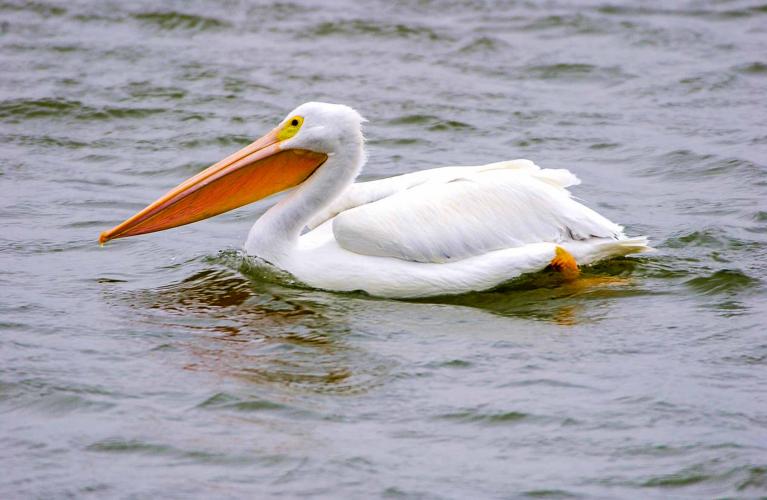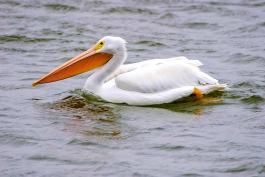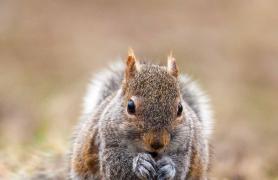Hi, I’m Sarah. I study and protect Missouri’s birds. And I love my job. Why? Because birds are awesome! They fly. They sing. They come in different colors, shapes, and sizes. So climb in for a fun flight. I’m going to show you why birds are the coolest creatures on the planet.
Fantastic Flyers
Birds are built for life in the skies. Hollow bones reduce weight. Beaks lack teeth — they’re too heavy. Feathers turn arms into wings. And strong chest muscles make flapping a snap. But birds don’t just fly. They swoop, soar, hover, and dive.
Soar
With dark feathers and a bald, wrinkly head, a turkey vulture won’t win many birdie beauty contests. But let it fly, and it just might win the talent show. These scruffy scavengers can soar for hours by holding their 6-foot wings in a shallow V.
Hover
Ruby-throated hummingbirds don’t sing, but they do hum. The buzzing sound comes from their wings, which they flap at blinding speeds — about 50 times each second! This helps a hummer hover like a helicopter so it can sip nectar from flowersand bird feeders.
Dive
Hang on! We’ve got to gun it to catch this fast flyer. Peregrine falcons are the speediest birds in the world. When one spots a yummy pigeon, it folds its wings and ... WHOOSH! Like a missile, it plunges toward its prey at 200 mph.
Migration Sensation
Protecting migratory birds is a tricky business. They don’t stay in one place for long. Take this cerulean (suh-rue-lee-un) warbler for example. During summer, it raises its babies in Missouri. But during fall, it flies to South America for winter. To thrive, warblers need healthy habitats here, there, and everywhere in between.
Bird Buffet
More than 300 kinds of birds turn up in the Show-Me State. And each one is equipped with a variety of tools that help it survive. To see for yourself, sneak a peek at this lineup of beaks — and eyes, wings, tails, and feet.
Beaks
- Red crossbills pry open pine cones with the crisscrossed tips of their freaky beaks.
- A shoveler’s snout is like a pasta strainer. Water drains out, but seeds and insects get trapped inside for the duck to munch.
- When a pelican wishes for fishes, it scoops them from the water with its pouchlike beak.
Eyes
- Thanks to eyes that stick out from the sides of its head, a woodcock can see up, down, and all around.
- A see-through extra eyelid slides into place to protect a bird’s peepers like a pair of goggles.
- An owl’s huge eyes gather lots of light and come in handy to snatch prey at night.
Wings
- Long, wide wings help this redtailed hawk soar long distances with little effort.
- A bobwhite’s stubby wings help it change direction quickly. But they aren’t good for flying far.
- A canvasback’s narrow, pointy wings let it zip through the sky at more than 60 mph.
Tails
- Male wild turkeys fan out their tails, then strut around to charm female turkeys.
- Stiff tail feathers keep a woodpecker from tipping over backwards while it hammers out holes.
- A scissor-tailed flycatcher uses its forked tail to swoop and swerve like a feathered fighter jet.
Feet
- Mallards use their webbed feet to paddle swiftly through the water.
- A yellowrumped warbler’s toes are tiny but tough. Could you hang on to a branch with your feet?
- Ospreys can bend their outer toes forward or backward to get a better grip on slippery fish — pretty talon-ted, huh?
Flashy Feathers
As you can see, birds wear a kaleidoscope of colors. Boy birds, believe it or not, are usually more colorful than girl birds. Why? A guy’s flashy feathers help him catch the eye of a mate. And a gal’s understated outfit helps her stay hidden when she’s sitting on a nest.
Teeny-Tiny to Big and Mighty
Birds come in an astonishing array of sizes. Missouri’s smallest bird is the rubythroated hummingbird. It weighs less than a nickel and has a wingspan of about 4 inches. At the other end of the scale, American white pelicans win the prize for longest wingspan — up to 9½ feet. And trumpeter swans, the Show-Me State’s heaviest bird, tip the scales at nearly 30 pounds.
Home Tweet Home
From city parks to the far-flung Ozarks, almost anywhere you go you’ll find a few beaked buddies to hang out with. Some birds live nearly everywhere. Others seek specific habitats in which tofind food, make homes, and raise babies.
Grassland
With lots of seeds and bugs, grasslands offer a buffet for birds. An upland sandpiper weaves through the wildflowers, jabbing its beak at grasshoppers and other insects. Male greater prairie-chickens stamp their feet and shake their tail feathers to charm female chickens. A dickcissel sings his name to proclaim this patch of prairie belongs to him.
Wetland
Wetland birds prefer life on the soggy side. Black-necked stilts wade through oozy mud and mucky water, snapping up aquatic creepy-crawlies. Wood ducks nest high in trees along marshes and streams. Male red-winged blackbirds sing from the tops of cattails to attract mates and warn other birds to KEEP OUT!
When you’re using binoculars, find the bird with your eyes first. Then — without taking your peepers off that bird — bring the binoculars to your eyes.
Forest
Deep in the shady forest, a barred owl uses its keen eyes and ears to detect rodents after dark. A pileated woodpecker bashes its beak into bark to nab tree-tunneling insects and hammer out homes. American redstarts flash their bright feathers to flush insects out of hiding. Scarlet tanagers creep through the canopy, bagging buzzy bees and wasps for breakfast. And a wood thrush’s sweet, flutelike song rings through the trees.
Backyard
Backyard birds don’t mind sharing space with people. Eastern bluebirds raise their babies in cavities, either in a tree or a birdhouse. Cardinals crack open seeds with their brawny beaks. A black-capped chickadee lets other birds know when danger lurks nearby by singing its name: chicka-dee-dee-dee.
Let’s Go Birding
Missouri’s wavy western prairies, rolling northern farmlands, rugged Ozark forests, and soggy Bootheel swamps offer plenty of places to see birds. But if you need help narrowing down your options, fly over to greatmissouribirdingtrail.com. There you’ll find a handy map of the best birding locations in the state.






















































Also In This Issue

This Issue's Staff
Les Fortenberry
Karen Hudson
Angie Daly Morfeld
Noppadol Paothong
Marci Porter
Mark Raithel
Laura Scheuler
Matt Seek
David Stonner
Nichole LeClair Terrill
Stephanie Thurber
Cliff White






















